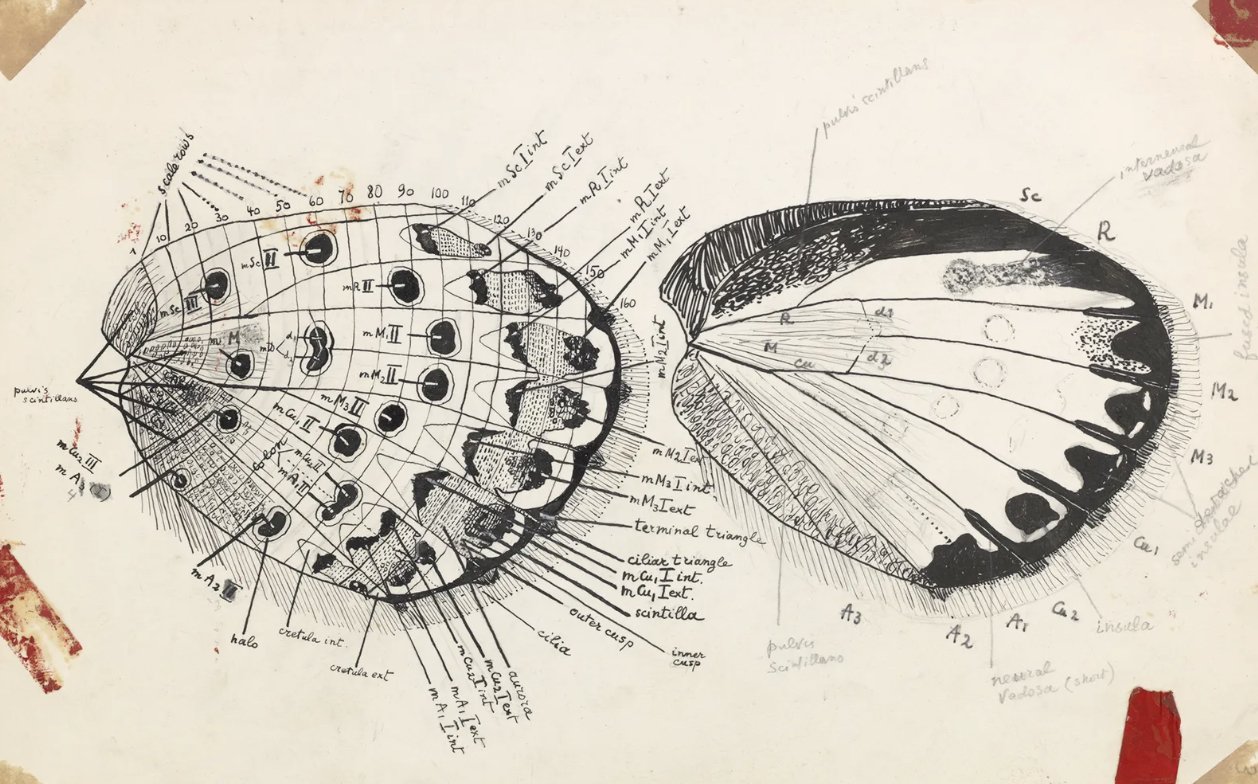Nabokov and his butterflies
Literature and butterflies are the two sweetest passions known to man. – Vladimir Nabokov
Image credit: New York Public Library
In a letter written in 1941 to his friend Edmun Wilson, Vladimir Nabokov wrote: “I am driving off to California to-morrow with butterfly-nets, manuscripts, and a new set of teeth.” On this road trip, Nabokov, along with his wife Véra, criss-crossed the United States for 240,000 kilometres, eagerly searching for butterflies to catch. In between grabbing gauzy white nets at highway road stops, Nabokov wrote furiously about the American landscape and culture that surrounded him on four-by-six index cards, notes that formed the basis for his most infamous work, Lolita. Driving full days around middle America and staying at places with names like the Lazy U Motel, the America Humbert presents to Lolita in a vibrant pastiche of motor lodges and kitschy roadside hotels, was the America reinvented under the same keen eye that the author brought to bear upon butterfly wings. In fact, Nabokov pays homage to a discovery he made of the first known female of the Lycaeides Sublinens found in Telluride, Colorado by naming the town of discovery in Lolita’s final scene.
The afternoon Nabokov sold the movie rights to Lolita for $150,000 in 1958 , Véra noted in her diary, “V. supremely indifferent - occupied with a new story, and with the spreading of some 2000 butterflies.”
It wasn’t until I read a collection of Nabokov’s essays and interviews that I learnt of his butterfly-studying career. I was immediately intrigued by how Nabokov, in almost every interview I read, mentioned butterflies, butterfly collecting or zoology. After some further research, I discovered that he published 18 science papers in the field of lepidoptery and became the de facto curator of lepidoptery at Harvard’s Museum of Comparative Zoology in 1947. Visiting the museum today, you’ll find a framed portrait of the author placed directly above his old desk. Over 20 species of butterflies have been named after his characters and over 550 mentions of butterflies have been spotted in his work. The interplay between Nabokov’s scientific spirit and artistic aesthetics provides a unique perspective in examining his works, one not frequently invoked. His years spent studying down the barrel of a microscope, fervently examining their patterns, mirror both the extreme technicality of his writing and the fleeting, pervasive playfulness of his prose.
Over his lifetime, he drew thousands of illustrations depicting the intricate anatomical structures of butterflies. The care invested in his scientific drawings show precision, to be sure, but they also show a level of detail, refinement and compositional care that goes beyond mere utility. I cannot help but wonder: did his attention to form, shape and colour, and the time spent intricately sketching and studying butterflies deepen the way Nabokov conceptualised artistic creation as a writer? Unexpectedly, he linked these two passions in his chosen research and writing medium: four-by-six index cards. The coincidence of the recording material indicates a commonality between the two kinds of information being recorded.
When asked to choose between his scientific and literary work in a 1964 interview for Die Welt, Nabokov responded, “Both belong together; for me one without the other is unthinkable, they augment each other.” His readiness to follow scientific pursuits alongside literature arguably enriched his representation of the delicate interconnectedness of things. Through constructing and embedding patterns in his fiction, Nabokov infused his works with a complexity that came closer and closer to matching that of the natural world. Some of these patterns include hidden and parodied literary allusions, typographical features such as typos, misspellings, anagrams, and acrostics, and natural repetitions such as butterflies, dogs, and trees. He collected, dissected, and illustrated butterflies with the same skill and precision that he used to create self-reflexive and intertextual novel forms. The encoding of subtextual meaning through weaving various webs of pattern creates a sort of ‘genetic structure’, which can be deconstructed microscopically, mirroring the delicate ‘scales’ of a butterfly wing in the overlapping forms his work takes. In approaching his works semi-scientifically, we too can share this ecstasy of discovery, the pleasure of minute analysis that lies in connecting the dots, putting the puzzle pieces together. Perhaps partaking in this form of study is to find the “delicate meeting place between imagination and knowledge” that Nabokov saw in butterfly anatomy.
Lecturing at Cambridge, Nabokov told his students that scientific study makes a “very apt” comparison to studying literature, as “whichever subject you have chosen, you must realise that knowledge in it is limitless. Every subject brims with mysteries and thrills.” Just as Nabokov’s artistic writings inspire with their precision, their sensuous beauty, and their perceptual complexity, so his scientific studies surprise and energise with their discovery of detailed minutiae, their attention to microscopic difference and their profoundly sustained engagement with tiny corners of the natural world. His frequent use of codes and games, the self-reflexivity of his writing resemble the playful movements of a butterfly fluttering from flower to flower, transitory and ornate. If beneath the surface of his works’ beauty lies a complex web of intertextual interconnection, it is because Nabokov believed the act of creation, like the scientific one, provides infinite opportunities to explore the intricacies of life in the inexhaustible world.

